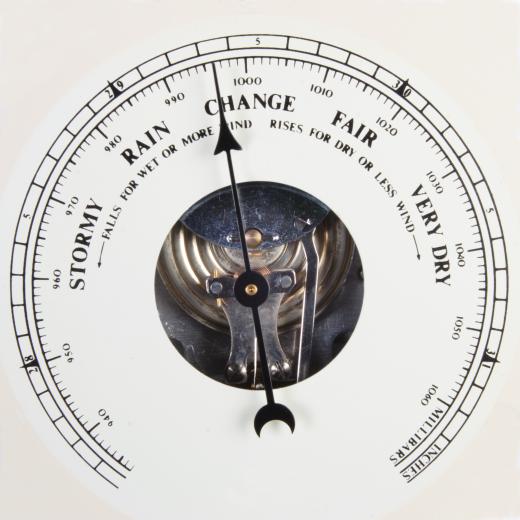What is a Differential Manometer?
A simple differential manometer consists of a U-shaped glass tube in which an inert liquid is placed. When the two arms of the U-shape are subjected to different pressures, the fluids in their respective tubes attain different heights. The change in pressure from one place to another can be determined by the difference in height of the fluid in the two arms. Differential manometers can range from devices simple enough to be built at home to electronic equipment with computer chips and digital readouts.
When the openings at the top of a differential manometer are exposed to the same pressure, atmospheric pressure for example, the liquid in the arms sits at equal heights. When another pressure is to be measured, the air pressure in a SCUBA tank, for example, the pressure of the air in the tank will push the fluid in the arm to which it is attached downward, while the fluid in the opposite arm rises.

To calculate the difference in pressure between the atmospheric air and the tank air, the difference between the height of the fluid in each arm is measured. Greater differences in pressure are measured using denser fluids, such as mercury, whereas lower differences in pressure can be made with less dense fluids, such as water.
When a weather forecaster speaks of a barometric pressure of so many millimeters (mm) of mercury, it can mean that the pressure difference between the inside and the outside of a storm will push the mercury up a differential manometer tube by that amount. For example, atmospheric pressure, 14.7 pounds per square inch (about 101 kPa), will push mercury up a tube 760 mm, whereas water would rise 33 feet. The eye of a category five hurricane at 13.3 psi (about 93 kPa) will push mercury up 690 mm, but water would rise 29.8 feet. Water rises much higher than the heavier mercury in the arm of the U-shaped tube, and so a simple manometer for water would be much larger than one that uses mercury. The pressure difference can be measured by multiplying the weight of the column of fluid by its change in height.

A portable differential manometer must use mercury and other low freezing point, high density, indicator fluids. Handheld, digital differential manometers have two external valves, each of which can be connected to a source of pressure. Battery driven digital manometers are button activated to produce readings in a number of different formats. Cables are available to connect portable units to computers for configuring results and designing reports.
AS FEATURED ON:
AS FEATURED ON:












Discuss this Article
Post your comments